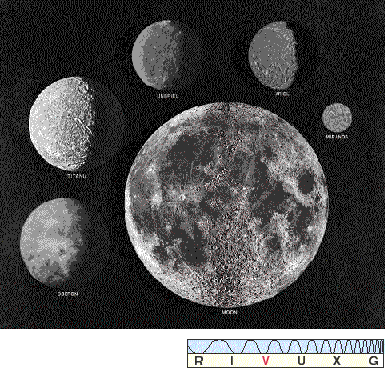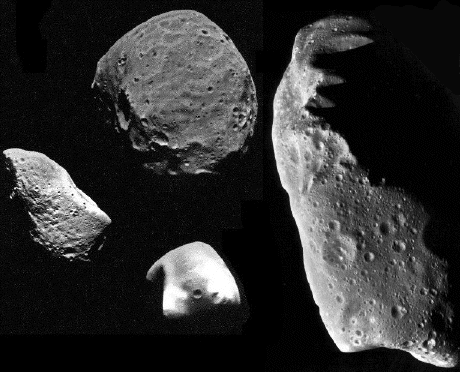Astronomy 1 - Physics 1513
Lecture Notes
Wednesday, Nov 25, 1997
Satellites of Uranus and Neptune
Pluto and Charon
Asteroids
Text Chapters (Chaisson and McMillan) = 13 and 14
NOTICES: Alternative Observation Session Report (See ACME and last Assignment) Final Exam Thursday, December 17th (9 am) Rm 10 Huggins Science Hall (location may be changed to a better room in HSH) Friday Nov 27 - Moon at First Quarter 1h UT (9pm AST) - Jupiter 0.6o N of the Moon (good time to observe relative motion of Moon to Jupiter and Stars!!) HOMEWORK: No More this term
Uranus, Neptuen and PLUTO
 Table to Summarize Properties
Uranus Neptune Pluto
Mean Distance Sun 19.2 AU 30.1 AU 39.5 AU
Period (years) 83.8 163.7 248.0
Orbit Eccentricity 0.046 0.009 0.249
Orbit inclination 0.8 1.8 17o
Equator Radius, km 25,560 24,760 1,190
R(earth) 4.00 3.89 0.19 = 1/5.4
Mass, M(earth) 14.5 17.1 0.0022
Density (kg/m3) 1290 1640 1,800
Rotaton (Interior, mag field) 17h14m 16h07m 6.39 days
Rotation (Equator, clouds) 16.5 h 17.3 h
Axial Inclination 98o 27o 123o
Magnet Strength m(Earth) 47 25 0
Solar Flux (W/m2) 3.6 1.5 0.86
Effective Temp 59 K 59K 40K
Rocky Core 0-7500 0-7000 0-900
liquid Mantle 7,500-25,000 7,000-24,000 900-1190 icy mantle
Atmosphere 10-6 bar
Hydrogen 90% 87%
Helium 9% 12%
Methane 1% 0.5%
Lost H2 Lost H2 more than Uranus
In Radiation Radiates 2.7 times
Balance with amount from Sun
Sun (???)
Equatorial Winds 350 km/hr ret. 1700 km/hr retrograde (east to west)
High Lat Winds 600 km/hr pro prograde
Both Uranus and Neptune are mostly blue featureless planets because ammonia is frozen out of the atmosphere. This leaves only the blue methane clouds with sometime white clouds of ammonia ice crystals.
Both planets have thin, narrow rings that are short lived.
Sizes are too small to be gas giants but more like icy, rocky planets
Major Satellites:
Table to Summarize Properties
Uranus Neptune Pluto
Mean Distance Sun 19.2 AU 30.1 AU 39.5 AU
Period (years) 83.8 163.7 248.0
Orbit Eccentricity 0.046 0.009 0.249
Orbit inclination 0.8 1.8 17o
Equator Radius, km 25,560 24,760 1,190
R(earth) 4.00 3.89 0.19 = 1/5.4
Mass, M(earth) 14.5 17.1 0.0022
Density (kg/m3) 1290 1640 1,800
Rotaton (Interior, mag field) 17h14m 16h07m 6.39 days
Rotation (Equator, clouds) 16.5 h 17.3 h
Axial Inclination 98o 27o 123o
Magnet Strength m(Earth) 47 25 0
Solar Flux (W/m2) 3.6 1.5 0.86
Effective Temp 59 K 59K 40K
Rocky Core 0-7500 0-7000 0-900
liquid Mantle 7,500-25,000 7,000-24,000 900-1190 icy mantle
Atmosphere 10-6 bar
Hydrogen 90% 87%
Helium 9% 12%
Methane 1% 0.5%
Lost H2 Lost H2 more than Uranus
In Radiation Radiates 2.7 times
Balance with amount from Sun
Sun (???)
Equatorial Winds 350 km/hr ret. 1700 km/hr retrograde (east to west)
High Lat Winds 600 km/hr pro prograde
Both Uranus and Neptune are mostly blue featureless planets because ammonia is frozen out of the atmosphere. This leaves only the blue methane clouds with sometime white clouds of ammonia ice crystals.
Both planets have thin, narrow rings that are short lived.
Sizes are too small to be gas giants but more like icy, rocky planets
Major Satellites:
 Uranus' largest satellites (Fig 13.11)
clockwize from the left [Oberon, Titania, Umbriel, Ariel, and Miranda]
Uranus Radius(km) Feature densities
Miranda 235 Huge V shaped groove 1,350 kg/m3
Ariel 580 40% albedo, large fractures 1,660
Umbriel 585 very dark, old surface 1,510
Titania 790 Heavily cratered 1,680
Oberon 760 ditto 1,580
Neptune
Uranus' largest satellites (Fig 13.11)
clockwize from the left [Oberon, Titania, Umbriel, Ariel, and Miranda]
Uranus Radius(km) Feature densities
Miranda 235 Huge V shaped groove 1,350 kg/m3
Ariel 580 40% albedo, large fractures 1,660
Umbriel 585 very dark, old surface 1,510
Titania 790 Heavily cratered 1,680
Oberon 760 ditto 1,580
Neptune
 Triton 1350 Retrograde orbit 2,070 dense
N2 atmosphere 2x10-5bar
Teff = 37K (Nitrogen Liquid at 77 K)
Decay of orbit due to Tides (moving closer to Neptune)
Nereid 340 Most Eccentric Orbit, far from Neptune
a = 233 RNep e = 0.75
Pluto
Charon 590 High inclination orbit 1,200
icy satellite
Orbits of Other Outer Solar System Objects - Asteroids
Triton 1350 Retrograde orbit 2,070 dense
N2 atmosphere 2x10-5bar
Teff = 37K (Nitrogen Liquid at 77 K)
Decay of orbit due to Tides (moving closer to Neptune)
Nereid 340 Most Eccentric Orbit, far from Neptune
a = 233 RNep e = 0.75
Pluto
Charon 590 High inclination orbit 1,200
icy satellite
Orbits of Other Outer Solar System Objects - Asteroids
ASTEROIDS
 Matilde (seen by NEAR)
ECU Shows Locations (Orbit Elements available from MPC)
Method of Discovery: Photography (2 photos separated by 1 hr) - Scan for movement
Rate of movement (in sky) ~ 15'/day ~ 40" arc/hr
Study: CCD => Astrometry (orbit), Photometry (rotation rates and shapes)
Naming Asteroids
When Discovered : New Designation
eg 1998WC2
1998 WC2 [ Amor type a=2.57AU e=0.57 i=27
perihelion = 1.105 AU: aph = 4.03 AU]
W = November 16-30 C = 3rd
2 = 3rd cycle of second letter
ie. 53rd asteroid in that 1/2 month
When Orbit determined (number in order of discovery)
When well determinied orbit (number)
Named by the International Astronomical Union - Minor Planet Center
eg. (4) Vesta, (624) Hektor, (5547) Acadiau
Main Belt and Kirkwood Gaps
(Resonance with Jupiter)
Earth Crossing Types (~1000 down to 1 km diameter)
Apollo: Crosses Earth's Orbit, eg (1566) Icarus
Atens: Entirely within Earth's Orbit
Amor: Crosses Mars Orbit but not the Earth's
Earth Spaceguard Foundation
"..an association aimed at the protection of the Earth
environment against the bombardment of objects of the
solar system (comets and asteroids)"
LIST of Closest Approaches of Asteroids
Trojon Asteroids (oscillate around 60 degree points of Jupiter's Orbit)
At present 431 are known: examples Hektor, Nestor, Achille, Ajax
In 1990 an asteroids at Mars' L5 point (trailing 60 degrees)was discovered
(5261) Eureka
Many distant asteroids (see internet) eg. Chiron, Hildago
PlOT of ASTEROIDS of INNER SOLAR SYSTEM
PLOT of ASTEROIDS of OUTER SOLAR SYSTEM
Properties
Sizes
Determined by visible and Infrared reflectance
Ceres largest at 940 km diameter
Pallas 540, Vesta 510, about 20, 200-300 km
Most < 200 km
Fragmentaton produces more smaller ones - roughly the same mass in each size group. eg 1000 more 10 km asteroids than 100 km asteroids etc.
Masses
Assume an average density
Total Mass < 0.001 Mass Earth.
Densities 2,500 kg/m3
Rotation
Measure the light curve variations
2 hours to 24hours typical
Surface Material
Spectra Reflectance and compare with Earth Rocks and Meteorites
C type Very Dark (albedo < 0.06) Match Carbonaceous Chrondrite Meteorites
(these are the most abundant type)
S type Bright (albedo 0.1-0.2) reddish , Like Stony meteorites (silicates)
M type Bright (albedo 0.1-0.2) no redness, Iron-nickle composition
Distribution:
S-type predominate in inner belt
C-type predominate in the outer belt (colder outer regions deposit more carbon)
Special Asteroids
(4) Vesta - High reflectivity - visible to naked eye (30% albedo)
Imaged by HST with rotation curves and mapped for bright, dark areas
Thought to be volcanic because spectra matches that of 4.5 billion year old lava
Has a higher density of 3.8 g/cc
Chiron show atmosphere (like a comet) when nearest the Sun.
Toro in synchonous orbit with Jupiter
Matilde (seen by NEAR)
ECU Shows Locations (Orbit Elements available from MPC)
Method of Discovery: Photography (2 photos separated by 1 hr) - Scan for movement
Rate of movement (in sky) ~ 15'/day ~ 40" arc/hr
Study: CCD => Astrometry (orbit), Photometry (rotation rates and shapes)
Naming Asteroids
When Discovered : New Designation
eg 1998WC2
1998 WC2 [ Amor type a=2.57AU e=0.57 i=27
perihelion = 1.105 AU: aph = 4.03 AU]
W = November 16-30 C = 3rd
2 = 3rd cycle of second letter
ie. 53rd asteroid in that 1/2 month
When Orbit determined (number in order of discovery)
When well determinied orbit (number)
Named by the International Astronomical Union - Minor Planet Center
eg. (4) Vesta, (624) Hektor, (5547) Acadiau
Main Belt and Kirkwood Gaps
(Resonance with Jupiter)
Earth Crossing Types (~1000 down to 1 km diameter)
Apollo: Crosses Earth's Orbit, eg (1566) Icarus
Atens: Entirely within Earth's Orbit
Amor: Crosses Mars Orbit but not the Earth's
Earth Spaceguard Foundation
"..an association aimed at the protection of the Earth
environment against the bombardment of objects of the
solar system (comets and asteroids)"
LIST of Closest Approaches of Asteroids
Trojon Asteroids (oscillate around 60 degree points of Jupiter's Orbit)
At present 431 are known: examples Hektor, Nestor, Achille, Ajax
In 1990 an asteroids at Mars' L5 point (trailing 60 degrees)was discovered
(5261) Eureka
Many distant asteroids (see internet) eg. Chiron, Hildago
PlOT of ASTEROIDS of INNER SOLAR SYSTEM
PLOT of ASTEROIDS of OUTER SOLAR SYSTEM
Properties
Sizes
Determined by visible and Infrared reflectance
Ceres largest at 940 km diameter
Pallas 540, Vesta 510, about 20, 200-300 km
Most < 200 km
Fragmentaton produces more smaller ones - roughly the same mass in each size group. eg 1000 more 10 km asteroids than 100 km asteroids etc.
Masses
Assume an average density
Total Mass < 0.001 Mass Earth.
Densities 2,500 kg/m3
Rotation
Measure the light curve variations
2 hours to 24hours typical
Surface Material
Spectra Reflectance and compare with Earth Rocks and Meteorites
C type Very Dark (albedo < 0.06) Match Carbonaceous Chrondrite Meteorites
(these are the most abundant type)
S type Bright (albedo 0.1-0.2) reddish , Like Stony meteorites (silicates)
M type Bright (albedo 0.1-0.2) no redness, Iron-nickle composition
Distribution:
S-type predominate in inner belt
C-type predominate in the outer belt (colder outer regions deposit more carbon)
Special Asteroids
(4) Vesta - High reflectivity - visible to naked eye (30% albedo)
Imaged by HST with rotation curves and mapped for bright, dark areas
Thought to be volcanic because spectra matches that of 4.5 billion year old lava
Has a higher density of 3.8 g/cc
Chiron show atmosphere (like a comet) when nearest the Sun.
Toro in synchonous orbit with Jupiter